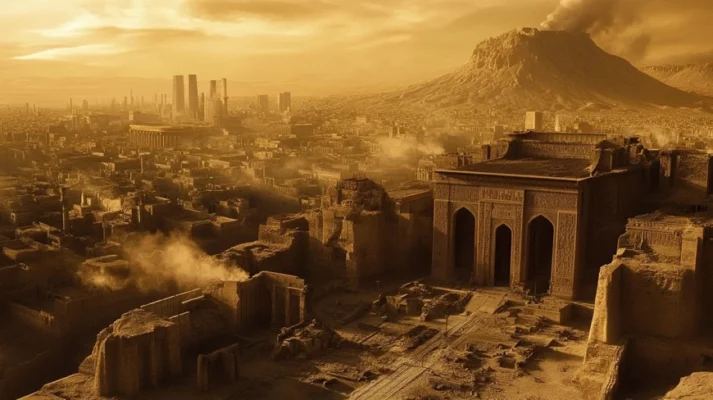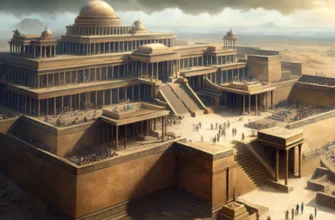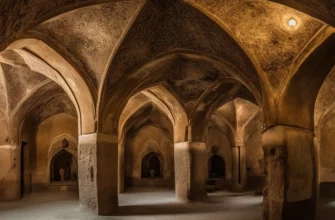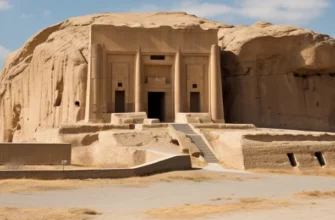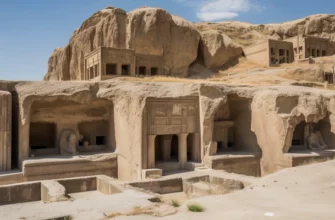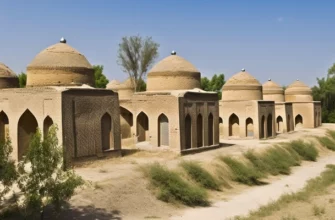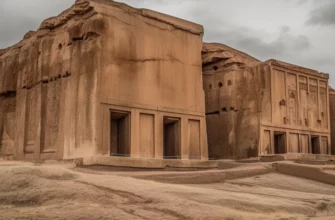Bishapur is an ancient city located in Iran, which became an important cultural and architectural center during the Sassanid Empire (224–651). The city was founded by King Shapur I after his victory over the Roman emperor Valerian in 260 AD. Bishapur served as the capital and administrative center of the empire, as well as an important trade hub.
One of Bishapur’s greatest treasures is its architecture, which combines Sassanid traditions with elements of Roman and Byzantine architecture. Among the main architectural monuments are huge palaces, temples, and famous rock reliefs depicting Emperor Shapur I and his military victories.
The city flourished in the 6th–7th centuries, but due to Arab attacks and growing political instability, Bishapur gradually declined and lost its importance.
Today, Bishapur is an archaeological site that attracts tourists and scholars researching Iran’s Sassanid heritage. Its monuments are part of the world’s cultural heritage and serve as an important source for studying the history and culture of ancient Iran.
- Historical context
- Bishapur as a capital
- Architecture and cultural heritage
- Main architectural monuments of Bishapur
- Cultural heritage of Bishapura
- Main architectural monuments
- The influence of Roman and Byzantine architecture
- Archaeological excavations in Bishapura
- Finds and their significance
- Temples and religious structures
- Palaces and their functional purpose
- Conclusions
Historical context
Bishapur was founded in the 3rd century CE during the reign of the Sassanid emperor Shapur I, which was an important stage in the history of Iran. The Sassanids, who came to power in Iran in 224 CE, replacing the Parthian dynasty, sought to restore the greatness of ancient Iran and build a new, powerful empire.
The founding of Bishapur took place after Shapur I’s great victory over the Roman emperor Valerian in 260 AD. This defeat of Rome, which was a significant political and military event, allowed Shapur to consolidate his power and establish a new capital in what is now Iran, which became a symbol of the power and achievements of the Sassanid rule.
Bishapur was located on an important trade and strategic route connecting different parts of the Sassanid Empire and served as the administrative and cultural center of the empire. The city combined features of traditional Iranian architecture with elements of Roman and Byzantine architecture, reflecting the intense cultural contacts between the Sassanids and other great civilizations of the time.
Shapur I actively supported the development of culture, religion, and science. Bishapur became an important cultural center, where huge palaces and temples were built, and monumental reliefs depicting military victories and important historical events were created.
During its heyday, especially in the 6th-7th centuries, Bishapur was one of the largest and most influential cities of the Sassanid Empire, but its decline began after the Arab conquests in the mid-7th century. After that, the city lost its importance and gradually declined, although its archaeological remains are still an important testimony to the power of the Sassanid era.
Bishapur as a capital
Bishapur played an important role during its heyday as one of the main administrative and cultural centers of the Sassanid Empire, although it was not the official capital of the empire on a permanent basis. However, during the reign of Shapur I and his successors, Bishapur did indeed become one of the key cities of the empire, where much of the political and cultural activity was concentrated.
Foundation and significance of Bishapur: After Shapur I’s victory over the Roman emperor Valerian in 260 CE, it was decided to found a new city that would become a symbol of the power of the Sassanid Empire and a place for administrative and military affairs. Bishapur was located at an important strategic crossroads of trade routes, which made it convenient for governing the empire.
The city also became an important political center, combining the traditions of ancient Iran with foreign influences, particularly Roman and Byzantine. The city’s architecture was notable for its monumental buildings, including palaces, temples, and other structures that emphasized the grandeur of the Sassanid Empire.
Bishapur’s influence on the empire: Although Ctesiphon, located in western Iran, was the actual capital of the Sassanid Empire, Bishapur became an important administrative center, especially after the victory of Shapur I. The city became a symbol of the restoration of Iran’s greatness and a center of cultural development, where science, art, and architecture flourished.
One of the distinctive features of Bishapur was its role in supporting the military power of the empire. Shapur I created a powerful army, and Bishapur became an important military center. The city also became a venue for major state ceremonies and the reception of foreign ambassadors.
Cultural significance: Bishapur was the center of much of the cultural life of the Sassanid Empire. The city became a place for the exchange of knowledge and ideas between Western and Eastern cultures. The architecture of Bishapur showed a mix of Sassanid traditions and influences from other cultures, especially Roman. Rock reliefs showing the victories of Shapur I, as well as amazing temples and palaces, show the rich cultural and artistic heritage of this city.
Role in the decline of the empire: Despite its heyday, Bishapura gradually lost its importance after the Arab conquests in the 7th century. After the fall of the Sassanid Empire, the city declined, but its architectural monuments remained an important testimony to the former greatness of Iranian civilization.
Thus, although Bishapur did not become the formal capital of the empire on a permanent basis, it served as an important political, military, and cultural center that left a significant mark on the history of Sassanid Iran.
Architecture and cultural heritage
The architecture of Bishapur is an important element of the cultural heritage of the Sassanid Empire, reflecting the high level of skill of ancient Iranian builders and architects. Founded by Shapur I after his victory over Rome, Bishapur became a symbol of the greatness of the Sassanid state.
The city’s architecture, combining Iranian traditions with Roman and Byzantine influences, is a testament to the cultural and political ties between the Sassanids and the Western powers of the time.
Main architectural monuments of Bishapur
Palaces and monumental structures: Bishapur was built according to the principles of a classical Sassanid city with huge palaces and monumental structures. The palaces probably served as residences for emperors and high-ranking officials. They were notable not only for their scale but also for their complex architectural solutions, the use of arches and domes, which became characteristic of Sassanid architecture.
Temples: The city had temples where the gods of Zoroastrianism were worshipped. The temples of Bishapura were built in the characteristic Sassanid style, which included huge spaces for prayers and rituals. These religious buildings usually had a high central part covered with a dome and were built on a rectangular or square plan.
Rock reliefs: One of the unique features of Bishapura is the numerous rock reliefs depicting important moments in the history of the Sassanid Empire, including the victory of Shapur I over the Roman emperor Valerian. These reliefs are not only works of art but also serve as documents reflecting the empire’s importance on the international stage and the Sassanids’ political ties with Rome.
Terraced slopes: The architects of Bishapura used complex engineering solutions, including terraced slopes, to build the city. This allowed them to maintain the stability of the structures and make maximum use of the space on the slopes, which is characteristic of many ancient cities in the Middle East.
Cultural heritage of Bishapura
Intercultural exchange: Bishapura was an important center for cultural exchange between Sassanid Iran and neighboring civilizations, particularly Rome and Byzantium.
Roman and Byzantine architecture strongly influenced the design of buildings in Bishapura, especially in the use of domes and arches, as well as in decorative elements such as frescoes and bas-reliefs.
Scientific and cultural center: In addition to its architectural heritage, Bishapur was also an important cultural and scientific center. Various fields of science flourished in the city, including astronomy, medicine, and philosophy. Bishapur became a place of learning and exchange of knowledge between scholars from different cultures.
Preservation of cultural heritage: Archaeological excavations in Bishapur are still ongoing, and the city has become an important source for the study of ancient Iran. The monuments of Bishapur, such as reliefs, buildings, and other archaeological finds, are of great importance for understanding the development of Sassanid culture and society.
Role in art history: Bishapur is an important stage in the development of Iranian art. The Sassanid architecture of the city, with its refined details and monumentality, became the basis for further architectural achievements in Iran and throughout the region, particularly during the Islamic period.
Thus, Bishapur is not only an architectural and engineering marvel of ancient Iran, but also an important cultural center that reflects the grandeur of the Sassanid Empire and its influence on surrounding civilizations.
Main architectural monuments
Bishapour is a city that has gained popularity thanks to its unique architecture, which reflects the heyday of the Sassanid Empire. The architectural monuments of Bishapur combine the traditions of ancient Iran with influences from Roman and Byzantine architecture. The city’s main architectural sites are impressive in their grandeur and craftsmanship, demonstrating the high level of development of construction technology at the time.
Palaces
One of the most important architectural monuments of Bishapura are the palaces that served as residences for emperors and the higher nobility. These palaces were notable not only for their enormous size, but also for their complex architectural solutions and the use of arches and domes. The palaces had multi-room complexes decorated with mosaics, frescoes, and other decorative elements reflecting the luxury of the imperial court.
Temples
Temples in Bishapura, as in other cities of the Sassanid Empire, are important religious and architectural monuments. They were distinguished by their grandeur and monumentality. Traditionally for the Sassanids, temples had a high central part covered with a dome. One of the most famous temples is the temple in the southwestern part of the city, which has a characteristic Sassanid architecture with the use of stone and tiles.
Rock reliefs
One of the most unique architectural features of Bishapura is the numerous rock reliefs depicting scenes from the life of Emperor Shapur I and his victories, including over the Roman Emperor Valerian. These reliefs are not only important historical documents but also wonderful examples of the art of that time. The reliefs are located in various parts of the city and provide valuable insight into the culture, religion, and politics of the Sassanid Empire.
Terraced slopes
A distinctive feature of the architectural layout of Bishapura is the use of terraced slopes. The city is located on the slopes of mountains, and terraces were used to construct buildings. This allowed for the stability of the buildings and optimized the space in the difficult local conditions. The terraced slopes also served an aesthetic function, giving the city an impressive appearance and making its architecture more distinctive.
Water structures and engineering solutions
Water supply was an important aspect of life in ancient Bishapura. Complex water structures were built in the city, including canals, reservoirs, and aqueducts, which provided the city with water. Water was also used for decorative purposes, particularly in palaces and gardens. The engineering solutions of the time demonstrate a high level of technological development.
Dome-shaped structures and arches
The architecture of Bishapura is characterized by the use of domes and arches, which became characteristic features of the Sassanid style. Domes had important functional and symbolic meanings, reflecting the grandeur of imperial power and religious traditions. Arches were used not only to support structures but also as decorative elements that added elegance and grandeur to buildings.
Triumphal arches and gates
Bishapur also has remains of triumphal arches, which served as symbols of military victories and were built to commemorate significant historical events. Such arches often featured sculpted depictions of military scenes and looked like impressive monuments commemorating imperial achievements.
Garden complexes
As in other Sassanid cities, Bishapura had developed garden complexes that were not only aesthetically pleasing but also practical. They served as places of recreation and assembly for rulers and their courtiers, and were also important parts of the city’s architectural layout.
The architectural monuments of Bishapura are an important testimony to the heyday of the Sassanid Empire and its cultural influence. From huge palaces and temples to unique rock reliefs, these structures are impressive for their beauty and technical perfection. Bishapur became one of the important cultural and architectural centers, reflecting the high skill of Iranian architects and builders of that time.
The influence of Roman and Byzantine architecture
The architecture of Bishapur, like that of other cities of the Sassanid Empire, is characterized by a combination of traditional Iranian building styles with influences from Western cultures, particularly Roman and Byzantine architecture.
This is due to many factors, including the Sassanids’ military victories over Rome, cultural exchanges, and close ties with the Byzantine Empire, which had a significant impact on the development of architectural forms and technologies in Iran.
Domes and arches
One of the most striking influences of Roman and Byzantine architecture on Bishapur is the use of domes and arches. These structures, characteristic of Roman and Byzantine buildings, were adapted and significantly improved by the architects of the Sassanid Empire. Dome-shaped structures, which became one of the hallmarks of Sassanid architecture, were used to create magnificent palaces, temples, and other public buildings. For example, in Bishapur, you can see the use of huge domes, which not only served a structural function but also symbolized the heavenly grandeur and divine power of the rulers.
Similar dome and arch designs were widely used by Roman and Byzantine architects, particularly in Roman baths and temples. The influence of Roman traditions on the construction of such structures in Bishapura is evident in the monumentality and efficiency of these designs for expanded interiors.
Multifunctional palaces and monumental structures
Roman and Byzantine palaces, such as the Palace of Diocletian in Spalato or the palace in Constantinople, became prototypes for the creation of large-scale architectural ensembles in Bishapura.
The palaces of the Sassanid rulers combined functional and decorative elements, allowing for the creation of huge interior spaces, which often had several levels and were divided into separate rooms for ceremonial ceremonies, recreation, and administrative activities. Roman and Byzantine architecture also made extensive use of monumental squares and a large number of decorative elements, which became characteristic of the palaces in Bishapur.
Engineering and water structures
The Romans were known for their engineering achievements, particularly in the construction of aqueducts and waterworks. This knowledge was transferred to Bishapur, where aqueducts and water systems were also used to supply water to the city and irrigate gardens. The Sassanids, in turn, developed these techniques, creating complex water systems for their cities, particularly in Bishapur.
The water structures in Bishapur were not only functional but also aesthetic. For example, the use of water in gardens and palaces was reminiscent of the Roman tradition, where water fountains and pools were important elements of garden complexes.
Mosaics and decorative art
Although Sassanid art generally focused on the use of stone and carving, the influence of Roman and Byzantine traditions can be seen in the decorative elements of Bishapura.
The mosaics, frescoes, and bas-reliefs of Roman and Byzantine architecture influenced Sassanid masters, resulting in Bishapur’s magnificent reliefs and other decorative elements that reflect a cultural synthesis.
Among them, the rock reliefs depicting the victories of Emperor Shapur I over the Roman Emperor Valerian are particularly noteworthy. This testifies to the use of Roman and Byzantine propaganda traditions through art, which impressed with its monumentality and symbolism.
City planning and fortifications
Urban planning in Bishapura was also influenced by Roman and Byzantine architecture. The Romans and Byzantines were masters of city and fortress planning, and these traditions were taken into account when creating Bishapura. The city had a strategically thought-out layout that took into account defensive functions, including fortifications and protective walls. The layout of Bishapura resembles Roman fortresses, in which strong walls, arches, and towers played an important role.
The architecture of Bishapura is a unique blend of Iranian traditions with Roman and Byzantine influences, demonstrating a high level of development and integration of different cultures. Roman and Byzantine architecture had a huge influence on the architectural forms and engineering solutions of the Sassanid Empire, which was evident in the construction of Bishapur. This cultural exchange allowed the city to become not only an administrative and military center, but also an important cultural center of its time.
Archaeological excavations in Bishapura
Archaeological excavations in Bishapura began in the 19th century, when the remains of this ancient city were first discovered. Since then, archaeologists have conducted numerous studies to uncover and preserve important elements of the cultural heritage of the Sassanid Empire. The excavations have allowed us to reconstruct an impressive picture of what life was like in Bishapura during its heyday.
The discovery of Bishapura
The first serious study of the archaeological sites of Bishapura took place in the mid-19th century, when French archaeologists led by Charles-Félix Vernet established a link between the city and the ancient Sassanid Empire.
Their excavations helped uncover numerous architectural remains that confirmed Bishapura’s importance as one of the empire’s key cities.
Major archaeological finds
Palaces and monumental buildings
One of the most important achievements of the archaeological excavations is the discovery of the remains of huge palaces and administrative buildings that once served as the residence of the emperors and high officials of the Sassanid Empire. Archaeologists have discovered the palace of Shapur I with domes and arches characteristic of the Sassanid style, which gives an insight into the architectural achievements of this period.
Temples and religious buildings
Bishapur was famous for its temples, where Zoroastrianism was worshipped. During excavations, the remains of temples were discovered, testifying to the popularity of this religion in Sassanid Iran. Characteristic elements, such as luxurious mosaics and bas-reliefs, allow researchers to reconstruct religious life in the city.
Rock reliefs
Important archaeological finds include rock reliefs depicting important historical events, including the victories of Emperor Shapur I over the Roman Emperor Valerian. These reliefs are not only works of art but also important historical documents that tell the political and military history of the empire.
Fortresses and fortifications
Excavations have also uncovered the remains of fortresses and fortifications that were of strategic importance. This testifies to the defensive role of Bishapur during the heyday of the Sassanid Empire.
Water and engineering systems
Archaeologists have also discovered complex water systems that supplied the city with water. Aqueducts, aqueducts, and water channels, which were built to irrigate gardens and provide essential water, demonstrate the high level of engineering skill of Sassanid architects. These water systems became an important part of the city’s infrastructure and have survived to this day.
Daily life and customs
Archaeological research also provides insight into the daily life and culture of the inhabitants of Bishapura. Artifacts such as pottery, jewelry, coins, and household items give us an idea of what everyday life was like in the city.
Coins found during excavations are important evidence of Bishapura’s economic activity and trade links with other parts of the empire.
Modern excavations and research
Modern archaeological work in Bishapura continues, and new discoveries are helping to uncover even more aspects of the city’s history. Bishapur has become an important site for international archaeological expeditions, and researchers are actively working to study not only architectural monuments but also to document the artifacts found. Such research contributes to the preservation of Iran’s cultural heritage and is important for understanding the development of the Sassanid civilization.
Preservation and protection of monuments
The preservation of the archaeological monuments of Bishapur is an important issue for Iran. Modern excavations and restoration work are aimed at preserving these valuable monuments for future generations. However, the cities and structures of Bishapur are threatened by erosion, climatic conditions, and human activity. Therefore, archaeologists and the Iranian authorities are actively working to preserve this heritage.
Archaeological excavations in Bishapur have revealed extremely important pages in the history of the Sassanid Empire and uncovered its cultural and architectural grandeur. The discoveries of palaces, temples, reliefs, and engineering systems not only confirm the city’s greatness during its heyday but also provide a deeper understanding of the life and culture of Bishapur, one of the largest centers of ancient Iran.
Finds and their significance
Archaeological excavations in Bishapur have uncovered many important finds that tell us about the culture, religion, economy, and technology of the Sassanid Empire. These artifacts not only testify to the high level of development of the city, but also help researchers gain a deeper understanding of its role in the context of ancient Iranian history.
Architectural remains and their significance
Palaces and monumental buildings
One of the most significant archaeological finds are the remains of palaces that served as residences for the emperors of the Sassanid Empire, including the palace of Shapur I. Architectural elements such as large domes, arches, and huge halls testify to the high level of Sassanid architectural skill. Preserved fragments of walls and floors help to study not only the architecture but also the decoration of the palaces, which contain elements of Persian, Roman, and Byzantine styles.
Temples and religious buildings
The remains of Zoroastrian temples discovered in Bishapur testify to the importance of this religion for the Sassanid Empire. The temple complexes, in particular their convenient location in cities and specialized architectural elements, allow researchers to understand how religious life was organized at that time. They also indicate the interaction of the Sassanid religion with other cultures, such as the Roman.
Rock reliefs and their historical significance
Reliefs of Shapur I
One of the most significant finds are the rock reliefs depicting important events in the history of Emperor Shapur I. The most famous of the reliefs is a scene depicting Shapur I’s victory over the Roman emperor Valerian. These reliefs not only demonstrate victory over enemies, but are also important documents for the history of that time, in particular for studying Sassanid military strategy and interaction with Rome.
In addition to reliefs depicting military scenes, reliefs depicting everyday life and religious rituals in Bishapura have also been found. They reflect the social structure, culture, clothing styles, and rituals of the time.
Artifacts of everyday life
Coins and monetary system
The coins found during the excavations are an important source for studying the economic activities of Bishapura and the Sassanid Empire in general. They reflect both internal trade relations and foreign trade with other cultures, including Rome and India.
The design of the coins and the inscriptions on them provide insight into the political situation and rulers of the time.
Tableware and household items
The tableware and household items found in Bishapura indicate a high standard of living for the urban population. Among the artifacts found are ceramic tableware, metal objects, jewelry, and even food processing tools. They help to reconstruct the daily life and social habits of the city’s inhabitants.
Jewelry and jewelry
The discovery of jewelry allows us to judge the aesthetic tastes and crafts of the Sassanid era. The beautiful gold and silver jewelry found during the excavations reflect the high skill of Persian jewelers and confirm the social status of the inhabitants of Bishapur.
Engineering and water systems
Water channels and aqueducts
One of the most impressive finds is the advanced water systems, including aqueducts, canals, and water pipes that supplied the city with water. This shows the high level of engineering and the importance of water in urban planning. Irrigation systems also helped maintain urban gardens and agricultural land around Bishapur, contributing to the city’s economic development.
Significance of the artifacts found
Historical and cultural value
The finds at Bishapur provide a deeper understanding of the culture, economy, and military strategies of the Sassanid Empire. They open important chapters in the history of Iran, allowing researchers to reconstruct not only the political but also the social aspects of life at that time.
Interaction with other cultures
Archaeological finds indicate that Bishapur was an important commercial and cultural center that maintained ties with other great civilizations of the time, including Rome, Byzantium, and India. Coins, pottery, and other artifacts testify to active foreign trade and cultural exchanges.
Preservation and restoration
The importance of the artifacts found lies not only in their historical value, but also in their significance for the preservation of Iran’s cultural heritage. Modern archaeological work on the restoration and preservation of Bishapur contributes to the study and promotion of this important historical site at the international level.
The finds made during the archaeological excavations of Bishapur are extremely important for understanding life in the Sassanid Empire. They open up new horizons for studying the culture, economy, and technology of the time, as well as helping to preserve the memory of one of the greatest cities of ancient Iran.
Temples and religious structures
As an important center of the Sassanid Empire, Bishapur was not only an administrative and cultural hub, but also had great religious significance.
Religion played an important role in public life, and it was in Bishapur that several important religious buildings were concentrated, reflecting the characteristics of Zoroastrianism, the state religion of the Sassanids. In addition, the city became a place for religious practices and symbols of imperial power.
Zoroastrian temples
Zoroastrianism was the main religion in the Sassanid Empire, and Bishapur was no exception. Zoroastrian temples in Bishapur played an important role in the religious life of the city and the empire as a whole. It was in these temples that religious rituals, sacrifices, and worship of deities were performed.
Layout and architecture
Zoroastrian temples were usually built as round or polygonal structures, reflecting the concept of cosmic order and the religion of fire. These temples had a central place for fire, a sacred element in Zoroastrianism, symbolizing purity, light, and divine power.
Architectural features
The architecture of Zoroastrian temples in Bishapur is characterized by the use of large domes, arches, and spacious halls. Technical solutions, such as special water channels and ventilation systems, reflect not only religious beliefs but also the high level of engineering of the time.
Terraced structures and the importance of outdoor space were also characteristic of Sassanid temples.
Fire temples
(Ateshkadeh)
Fire temples, or Ateshkadeh, were central religious buildings in the Sassanian Empire. They became important not only for religious practices but also as symbols of the empire’s power and might.
Ateshkadeh in Bishapur
In Bishapur, archaeologists have discovered the remains of a fire temple that was part of a large architectural complex. The central element of the temple was a large fire that was kept burning for many years. The cult of fire in Zoroastrianism had symbolic significance, as fire was considered an image of purity and divine incarnation.
The role of Ateshkadeh in society
Fire temples were not only places for religious rituals, but also important cultural and social centers. They became gathering places for educated people and served as places for teaching young people, which emphasizes their importance in the development of culture and science at that time.
Temples and symbols of the empire
The temples in Bishapura also served as symbols of state power. The Sassanids often built huge religious structures that simultaneously symbolized their divine right to the throne and the higher status of the empire. Emperors attached great importance to religious buildings, which were supposed to reflect the power and stability of their rule.
The city as a symbol of imperial grandeur
The huge temples and their architectural features in Bishapura became part of imperial propaganda, demonstrating the power and divine support of the imperial authority. The temples had not only religious but also political significance, emphasizing the connection between spiritual and secular power.
Other religious structures
In addition to Zoroastrian temples, there were other religious buildings in Bishapura associated with various cultures with which the Sassanids had contact. Religious complexes that emerged as a result of interaction with Roman and Byzantine cultures occupied an important place.
Pagodas and Christian churches
Due to Bishapura’s location on important trade routes, cultural and religious interaction with other civilizations took place here. As a result, religious buildings appeared that reflected the influence of Buddhism and Christianity, particularly in regions under Roman influence.
The role of temples in the development of the city
The temples of Bishapura became not only religious centers but also important parts of the city’s cultural and social infrastructure. They served as centers of spiritual and cultural life, preserving and transmitting knowledge, traditions, and rituals through generations. At the same time, these temples became places for social interaction, education, and even science.
The temples and religious structures of Bishapura played a central role in the life of the city and were not only religious centers but also important cultural and social centers. Fire temples, Zoroastrian rituals, and other religious structures demonstrate the religious scope of the Sassanid Empire and its deep respect for spiritual and secular authority. The architectural and cultural religious monuments of Bishapur are important for studying not only the religious practices of the time, but also for understanding the imperial structures and cultural interactions between different civilizations.
Palaces and their functional purpose
As one of the main centers of the Sassanid Empire, Bishapura was not only a cultural, religious, and administrative center, but also an important location for palaces that had a great influence on the political and social structure of the empire. The palaces in Bishapur were symbols of the empire’s power, venues for important political events and religious ceremonies, as well as administrative centers for governing the vast territories of the Sassanid state.
Palace of Shapur I
The Palace of Shapur I in Bishapura is one of the most famous architectural complexes associated with the Sassanid Empire. This palace was built in honor of Emperor Shapur I and is a striking example of Sassanid architecture, combining elements of Persian tradition and Roman style.
Function:
The palace served as the residence of the emperor and senior officials, as well as a venue for ceremonial events such as receptions for ambassadors, victory celebrations, and state ceremonies. It was also an administrative center where important political decisions were made. The huge halls and complexes allowed for large gatherings and ceremonial meetings.
Architecture and layout:
The palace has the characteristic features of Sassanid architecture: large domes, spacious halls, and arches that impress with their grandeur and stability. Individual rooms, such as throne rooms and the emperor’s residences, were designed to emphasize the hierarchical status of the ruler and his entourage. The interiors were decorated with luxurious mosaics, bas-reliefs, and exquisite frescoes.
Political and administrative role of palaces
The palaces in Bishapura not only served as residences for emperors, but were also key centers of empire administration. They served as venues for state council meetings and important consultations, as well as for making decisions that had a major impact on the empire’s politics and strategy.
A place for diplomacy:
The palaces became important venues for diplomatic relations between the Sassanids and other states. The reception of ambassadors and the discussion of peace agreements or trade terms took place in luxurious throne rooms, emphasizing the importance and grandeur of the empire.
Centers of political power:
In addition to their function as residences, palaces became centers of power. They provided for the administration and organization of state affairs and controlled strategically important territories of the empire.
Religious role of palaces
The palaces of Bishapura also had religious significance. They became important places for religious rituals such as fire worship, Zoroastrian rites, and state holidays that included religious ceremonies. The Sassanid emperors often acted not only as political leaders but also as defenders of the faith and its chief patrons.
Fire in palaces:
Fire, as a symbol of divine power and purity in Zoroastrianism, had special significance in palaces. Many palaces had specially equipped places for maintaining sacred fires. This religious practice not only maintained the spiritual atmosphere but also symbolized the preservation of the empire under the protection of divine forces.
Religious rituals and celebrations:
Palaces served as venues for religious rituals in honor of the gods and for celebrations of the empire’s great victories. This emphasized the connection between divine powers and imperial authority, creating an atmosphere of grandeur and immutability.
Palaces as symbols of imperial grandeur
The palaces of Bishapura also served as symbols of imperial grandeur and power. The majestic structures with huge domes and halls containing numerous decorations and sophisticated architectural elements emphasized the power of the rulers and their divine origin. They became architectural symbols of the stability and prosperity of the empire.
Propaganda of imperial power:
Through the grandeur of their palaces, the Sassanid emperors emphasized their status not only as rulers of earthly territories, but also as divine representatives on earth. The palaces became important instruments of imperial propaganda.
Aesthetic significance:
In addition to their political and religious functions, the palaces of Bishapura were aesthetically impressive. The architecture of the palaces included large mosaics, bas-reliefs, frescoes, and intricate details that reflected the cultural achievements of the Sassanid era.
Palaces and social structure
The palaces also reflected the social hierarchy in Bishapura. They were places where the upper classes of the empire, from rulers to high-ranking officials, had access to luxury and privileges that emphasized their status in society. At the same time, palaces served as examples for craftsmen and builders, showcasing achievements in architecture and engineering.
The palaces of Bishapura had a multifunctional purpose. They were not only the residences of emperors, but also centers of political, religious, and cultural activity. Thanks to their grandeur and luxury, the palaces became important symbols of the Sassanid Empire, emphasizing the power and stability of the reign of Shapur I and other rulers. Their architectural and functional significance in the history of Iran remains unquestionable.
Conclusions
Bishapur is of great importance for the modern understanding of ancient Iran. This city is a unique source of knowledge about the Sassanid Empire, one of the most powerful states of the ancient East. Its architecture, palaces, temples, and other monuments testify to the high level of development of culture, art, religion, and administrative organization in Iran at that time. Bishapur reflects the close ties between Iranian civilization and the Roman, Byzantine, and even Indian worlds, providing a better understanding of the processes of cultural exchange and influence.
The city has become a key site for archaeologists, who have been able to reconstruct life in the Sassanid era through excavations. The finds, ranging from mosaics to monumental structures, confirm the flourishing of art and architecture, as well as religious practices, particularly Zoroastrianism. Bishapur is also important for the formation of Iran’s national identity, as it embodies the greatness and uniqueness of the ancient Persian civilization.
Its influence extends far beyond modern Iran — it is a symbol of dialogue between cultures, proof of the diversity of historical heritage, and a reminder of the importance of preserving cultural monuments as a source of knowledge about humanity’s past.
